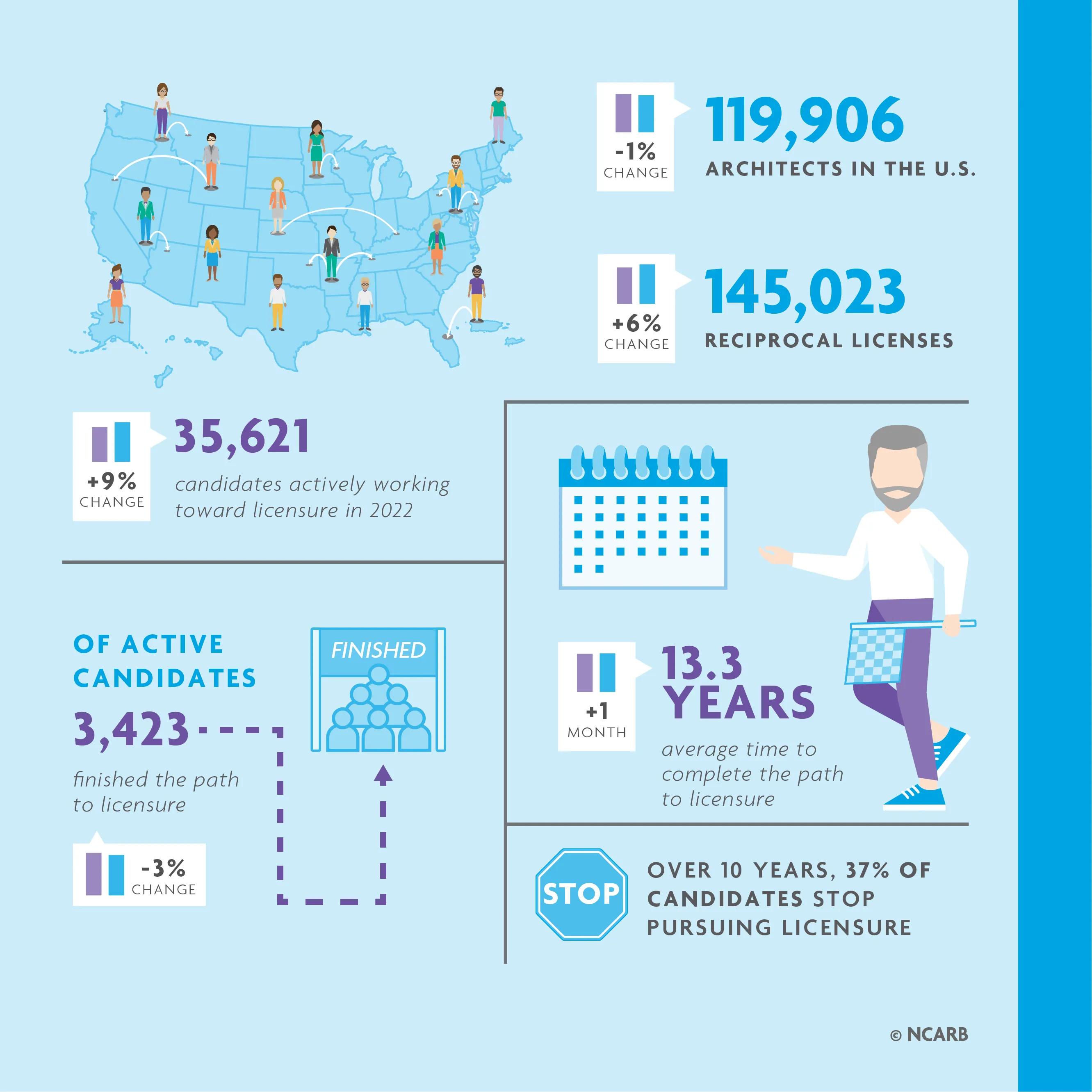
In 2022, there were nearly 120,000 licensed architects across the 55 U.S. jurisdictions. Those architects also held approximately 145,000 reciprocal (out-of-state) licenses—a 6% increase compared to 2021—signaling the increased demand for professional mobility since the onset of the COVID-19 pandemic.

The number of candidates who made progress on the path to licensure in 2022 also rose by 9%, with more than 35,000 candidates reporting experience, taking the national licensing exam, or both. And at 13.3 years, the average time a candidate takes to complete these core requirements is about 2% longer than five years ago.
Over 3,400 candidates completed the path to architectural licensure in 2022, a slight decrease from 2021. This small dip could be a result of fewer candidates completing the experience program in recent years, as well as the continued impact of COVID-19 on candidates’ careers.
The number of architects licensed in the United States remained relatively steady in 2022, decreasing by around 1% to 119,906—about 1,600 fewer than the number seen in 2021, according to data from NCARB’s annual Survey of Architectural Registration Boards.
Though the number of architects rose steadily from 2016-2020, the slight dip in recent years is likely due to the ongoing effects of the COVID-19 pandemic, as the historically low number of new architects seen since the pandemic’s onset has not offset the number of existing architects retiring from the profession.
In addition, the Survey of Architectural Registration Boards indicated that the number of reciprocal licenses held by U.S. architects rose from 136,614 in 2021 to 145,023 in 2022, a 6% increase. This is approximately 20% higher than the number of architects in the United States, signaling that the average architect is licensed in more than one jurisdiction.
The rise in the number of reciprocal licenses reflects the increased demand for professional mobility and flexibility since the onset of the COVID-19 pandemic. With an increasingly global economy and NCARB’s continued pursuit of greater international opportunities for NCARB-certified architects, it is likely that the demand for reciprocal licenses will continue to grow in the coming years.
Since the pandemic-related drop in candidate activity seen in 2020, the number of licensure candidates making progress toward licensure has been steadily recovering. In 2022, more than 35,000 candidates reported experience, took an exam division, or both—a 9% increase from 2021.
Most of these individuals—19,710 candidates—reported experience but didn’t test, a 17% increase from 2021 and the highest number seen since before the pandemic. Another 3,809 candidates were taking the ARE and reporting experience, and 12,102 did not report experience but took at least one exam division.
Just over 3,400 candidates completed the path to architectural licensure in 2022, 3 percentage points less than in 2021. This slight dip may be an effect of the decline in candidates completing the experience program in recent years, as well as the continued impacts of COVID-19 on candidates’ career paths.
The path to architectural licensure includes earning a degree from an accredited architecture program and completing the national experience and examination programs. Achieving these key requirements for licensure is a reliable indicator that an individual has become (or will soon become) licensed in a U.S. jurisdiction.
From beginning their first college degree to finishing their final licensure requirement, the average candidate who completed the path to licensure in 2022 took 13.3 years to do so, around one month longer than in 2021.
On average, 7.4 of those years were spent completing NCARB’s experience and examination programs
In 2022, 53% of candidates who started their NCARB Record five years ago (in 2018) were still actively pursuing a license, and 38% were not actively pursuing licensure.
Of candidates who started their NCARB Record 10 years ago (in 2013), a quarter (25%) were still actively working toward earning their license, and 37% had stopped pursuing licensure. The remaining 38% of candidates who started their Record 10 years ago have since earned their license.
By Race and Ethnicity
At both the five- and 10-year mark after starting an NCARB Record, white candidates had the lowest proportion of inactive licensure candidates at 34% and 33%, respectively.
Black or African American candidates had the highest proportion (36%) of active candidates after 10 years, aligning with NCARB data that indicates Black candidates take longer than those of other races and ethnicities to be ready for licensure. At 46%, candidates who chose “Another Group” when selecting their race and ethnicity were the most likely to fall off the licensure path after 10 years.
By Gender
There was less variance among candidates when viewing the data by gender. For example, 10 years after starting an NCARB Record, 37% of both men and women were no longer active on the path to licensure.
The greatest gap between men and women was seen for active licensure candidates at the five-year mark, where women were 5 percentage points more likely than men to be active (56% vs. 51%).
By Age
When filtering the data by age, 18-22-year-olds had the largest proportion (62%) of active candidates at the five-year mark. Only 35% of candidates aged 55+ were active within five years of starting an NCARB Record.
By Race and Ethnicity
Across the years, white candidates remain the least likely racial and ethnic group to fall off the path. The gap between races and ethnicities does begin to shrink, however, for candidates who started an NCARB Record in 2013 and later.
For candidates who started the path to licensure between 2008-2012, there is a 13 percentage point gap between the least likely group (white candidates) and the most likely group (Black or African American candidates) to fall off the path. Additionally, one-fifth of African Americans fell off the path before starting NCARB programs. Asians were the next most likely group to fall off the path, typically while taking the ARE. Today, 18% of African Americans who started the path between 2008-2012 are now licensed architects, compared to 43% of white Record holders.
For candidates who started their licensure journey slightly later (between 2013 and 2017), the gap between the least likely group (white candidates) and the most likely group (Asian candidates) to fall off the path is 10 percentage points. Additionally, candidates of all races and ethnicities were most likely to fall off the path while earning professional experience.
For those who recently started the path to licensure (2018-2022), 74-79% of individuals across racial and ethnic groups are still active on the path. Individuals of “another group,” which includes candidates who identify as Native American and Native Pacific Islander, were the most likely to fall off the path at 27%, closely followed by African American and Asian candidates, both at 26%. Most candidates that fell off the path did so before starting NCARB programs or while working to gain and report professional experience. See more details on the following page.
By Gender
For candidates who started the path to licensure a decade or more ago (between 2008- 2012), women were 4 percentage points more likely to fall off the path to licensure than men 45% vs. 41%). Both men and women who started the licensure path between 2008- 2012 were most likely to fall off the path while taking the ARE. 39% of men and 36% of women who started the licensure path between 2008-2012 are now licensed architects.
The attrition seen between men and women shifted for candidates who started the path to licensure between 2013-2017, with nearly equal proportions of men and women falling off the path at (38% versus 37%)—typically while gaining professional experience or testing for the ARE.
For candidates who recently started the path to licensure (2018-2022), men were slightly more likely to fall off the path than women. Women who recently started the path were also more likely to be actively pursuing an architecture license at 75%, versus 71% of men.
By Age
For more than a decade, younger candidates have been less likely to fall off the path to licensure than candidates over 40. For candidates who started the licensure path between 2008-2012, those aged 40-54 were 11 percentage points more likely to fall off the path than 23-29-year-old candidates (51% vs. 40%). Additionally, nearly a quarter of 55+ candidates (24%) fell off the path before starting NCARB programs.
For those who started the licensure path slightly later (2013-2017), the gap between the least likely and most likely age group to fall off the path widened: candidates aged 55+ were 23 percentage points more likely to fall off the path than 18-to-22-year-old candidates (57% vs. 34%). Most candidates over 40 fell off the path while taking the ARE, while 18-29-year-old candidates were more likely to fall off the path while working to gain professional experience.
The attrition between age groups decreased for those who started the path to licensure more recently (2018-2022), with 70-81% of individuals of all ages remaining on the path. Most candidates who did become inactive fell off before starting NCARB programs, with individuals aged 40-55+ the most likely to become inactive.
